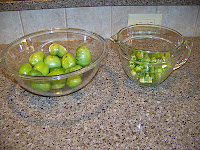By request, our contractor donated everything that was removed to Habitat for Humanity's local ReStore. We replaced our refrigerator with an energy star appliance and it was even eligible for a rebate from our local provider.

The most innovative and exciting upgrade we made was utilizing new LED under-cabinet lights. For anyone unfamiliar, LED stands for Light Emitting Diode, and Consumer Reports explains LEDs: Light-emitting diodes, the newest choice, were the most energy efficient under-cabinet lighting by far. Their low-profile housings tend to be relatively discreet.
Household applications for LEDs are increasing as the old incandescent bulbs are phased out and folks have concerns about using fluorescent bulbs. Currently, LEDs are a bit pricey, but the energy savings will offset for the higher price. In 2009, The Simple Dollar, a financial tip site, did a side by side comparison of CFL (compact fluorescent light), LED, and incandescent bulbs. LEDs were by far the most efficient, but also suggested that they'd soon be the most economical, as the prices dropped. Their site recommends a $15 price point as the benchmark. LED's longevity factor is also attractive for hard to reach bulbs, the US Department of Energy estimates that LEDs can last up to 50,000 hours, compared to 10,000 for a CFL. Some additional advantages to LED lights is that they turn on immediately, they can be dimmed, and they do not generate heat. The newer LEDs cast warm colored light, not blue like the earlier ones.

As indicated by the photo, our inobrusive LED lights brighten our kitchen workspace tremendously. We highly recommend learning about and using LEDs.











